Organisational Behaviour Report: Team Development and Leadership
VerifiedAdded on 2021/02/19
|10
|2643
|27
Report
AI Summary
This report on organizational behavior delves into the distinctions between groups and teams, highlighting the characteristics of effective and ineffective teams. It examines Tuckman's team development theory, outlining the stages of forming, storming, norming, performing, and adjourning, and also introduces Belbin's team role theory, exploring various roles like implementer, shaper, finisher, coordinator, team worker, resource investigator, evaluator, specialist, and plant. The report further discusses the Path Goal Theory, focusing on leadership styles and their impact on employee motivation and performance. It identifies barriers to effective performance, such as unclear goals and poor communication, and emphasizes the importance of addressing these issues to improve organizational outcomes. The report concludes by exploring how organizational behavior concepts such as motivation and individual differences can inform and influence behavior, both positively and negatively, within an organizational context.
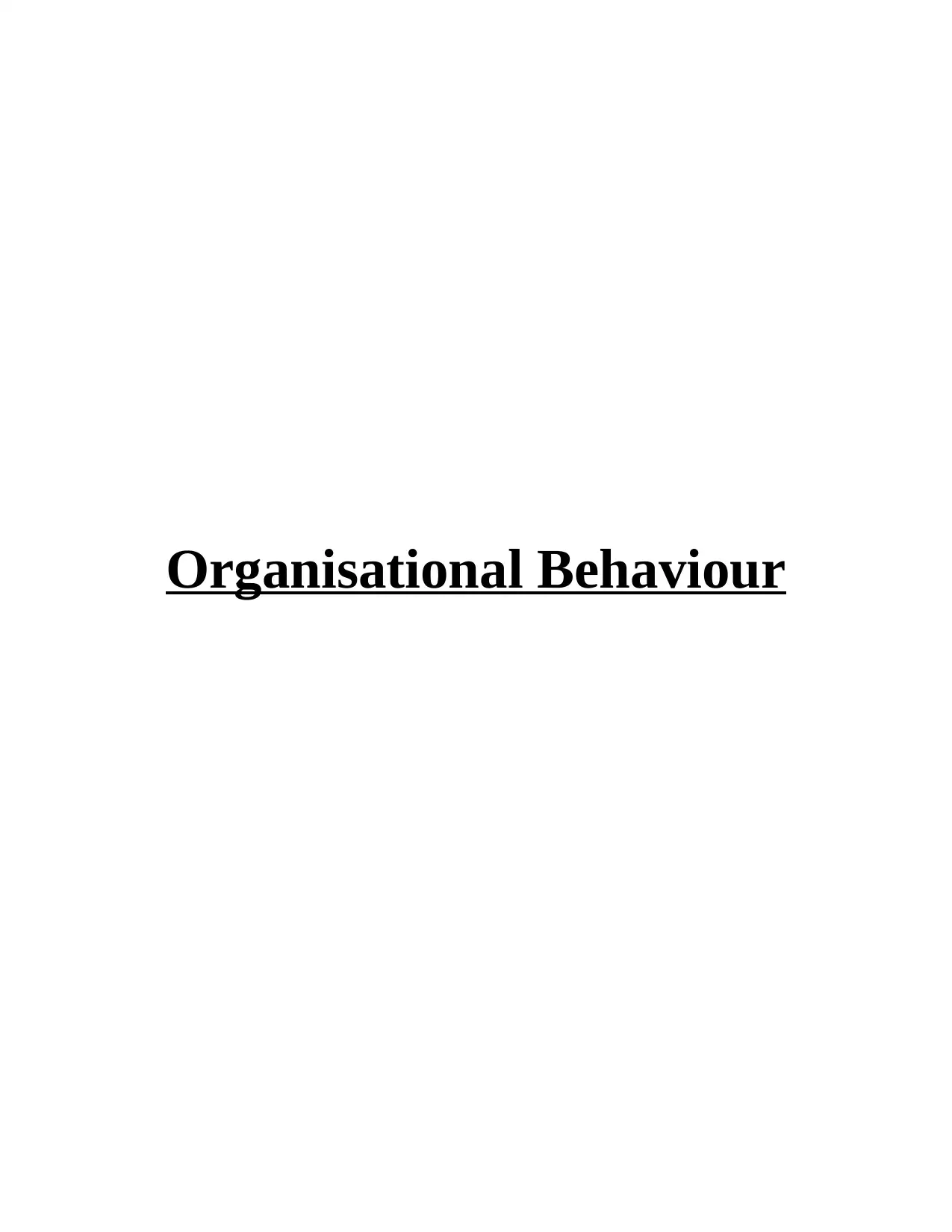
Organisational Behaviour
Paraphrase This Document
Need a fresh take? Get an instant paraphrase of this document with our AI Paraphraser
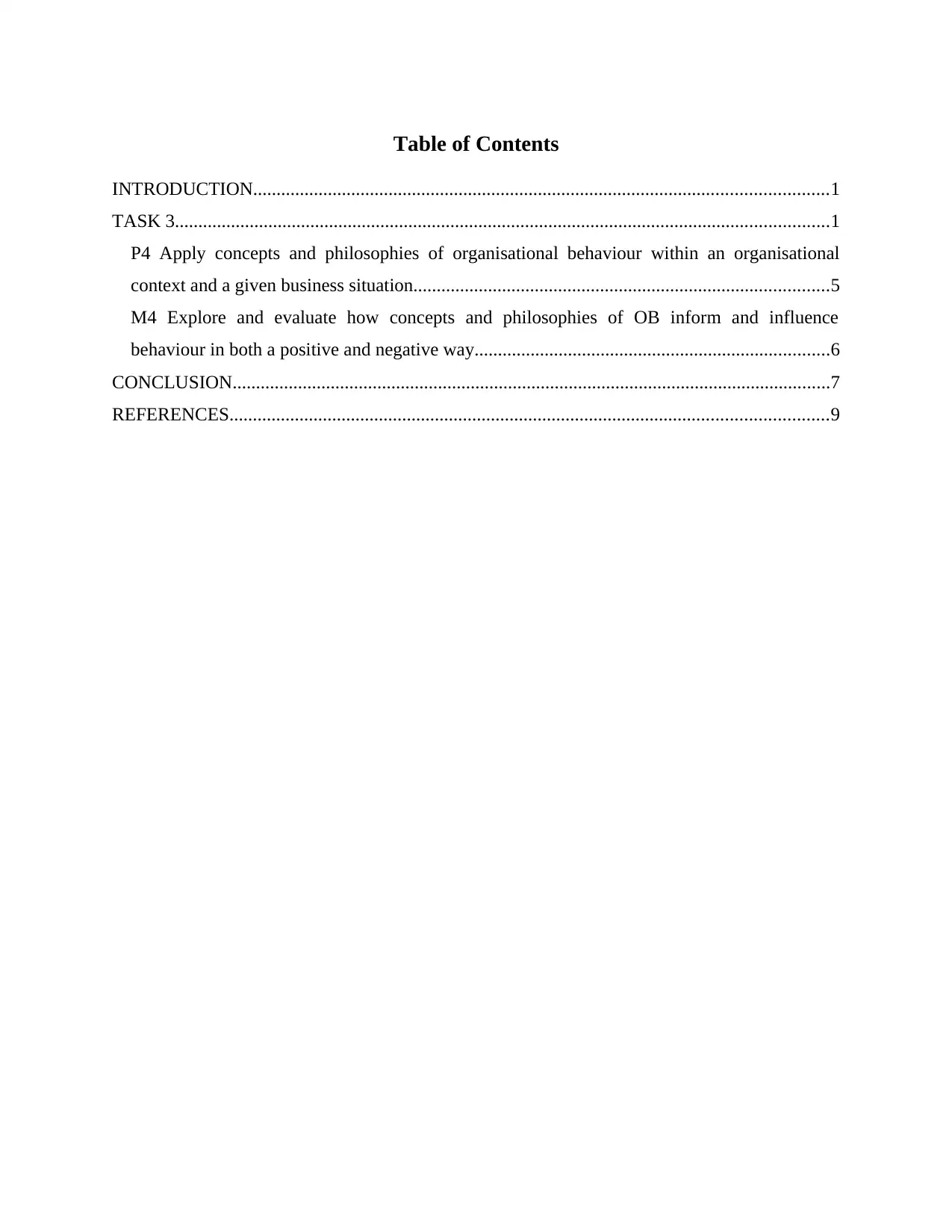
Table of Contents
INTRODUCTION...........................................................................................................................1
TASK 3............................................................................................................................................1
P4 Apply concepts and philosophies of organisational behaviour within an organisational
context and a given business situation.........................................................................................5
M4 Explore and evaluate how concepts and philosophies of OB inform and influence
behaviour in both a positive and negative way............................................................................6
CONCLUSION................................................................................................................................7
REFERENCES................................................................................................................................9
INTRODUCTION...........................................................................................................................1
TASK 3............................................................................................................................................1
P4 Apply concepts and philosophies of organisational behaviour within an organisational
context and a given business situation.........................................................................................5
M4 Explore and evaluate how concepts and philosophies of OB inform and influence
behaviour in both a positive and negative way............................................................................6
CONCLUSION................................................................................................................................7
REFERENCES................................................................................................................................9
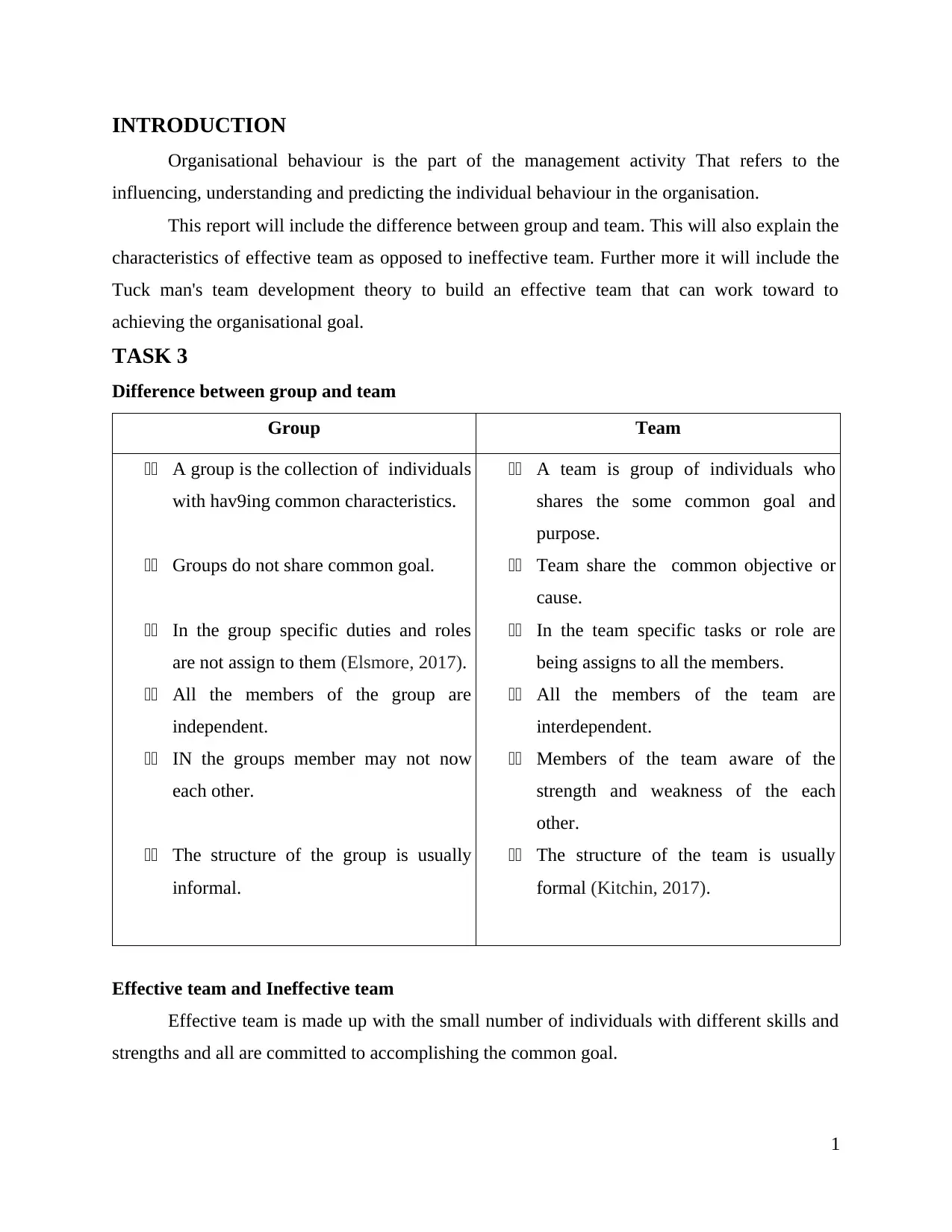
INTRODUCTION
Organisational behaviour is the part of the management activity That refers to the
influencing, understanding and predicting the individual behaviour in the organisation.
This report will include the difference between group and team. This will also explain the
characteristics of effective team as opposed to ineffective team. Further more it will include the
Tuck man's team development theory to build an effective team that can work toward to
achieving the organisational goal.
TASK 3
Difference between group and team
Group Team
11 A group is the collection of individuals
with hav9ing common characteristics.
11 Groups do not share common goal.
11 In the group specific duties and roles
are not assign to them (Elsmore, 2017).
11 All the members of the group are
independent.
11 IN the groups member may not now
each other.
11 The structure of the group is usually
informal.
11 A team is group of individuals who
shares the some common goal and
purpose.
11 Team share the common objective or
cause.
11 In the team specific tasks or role are
being assigns to all the members.
11 All the members of the team are
interdependent.
11 Members of the team aware of the
strength and weakness of the each
other.
11 The structure of the team is usually
formal (Kitchin, 2017).
Effective team and Ineffective team
Effective team is made up with the small number of individuals with different skills and
strengths and all are committed to accomplishing the common goal.
1
Organisational behaviour is the part of the management activity That refers to the
influencing, understanding and predicting the individual behaviour in the organisation.
This report will include the difference between group and team. This will also explain the
characteristics of effective team as opposed to ineffective team. Further more it will include the
Tuck man's team development theory to build an effective team that can work toward to
achieving the organisational goal.
TASK 3
Difference between group and team
Group Team
11 A group is the collection of individuals
with hav9ing common characteristics.
11 Groups do not share common goal.
11 In the group specific duties and roles
are not assign to them (Elsmore, 2017).
11 All the members of the group are
independent.
11 IN the groups member may not now
each other.
11 The structure of the group is usually
informal.
11 A team is group of individuals who
shares the some common goal and
purpose.
11 Team share the common objective or
cause.
11 In the team specific tasks or role are
being assigns to all the members.
11 All the members of the team are
interdependent.
11 Members of the team aware of the
strength and weakness of the each
other.
11 The structure of the team is usually
formal (Kitchin, 2017).
Effective team and Ineffective team
Effective team is made up with the small number of individuals with different skills and
strengths and all are committed to accomplishing the common goal.
1
⊘ This is a preview!⊘
Do you want full access?
Subscribe today to unlock all pages.

Trusted by 1+ million students worldwide
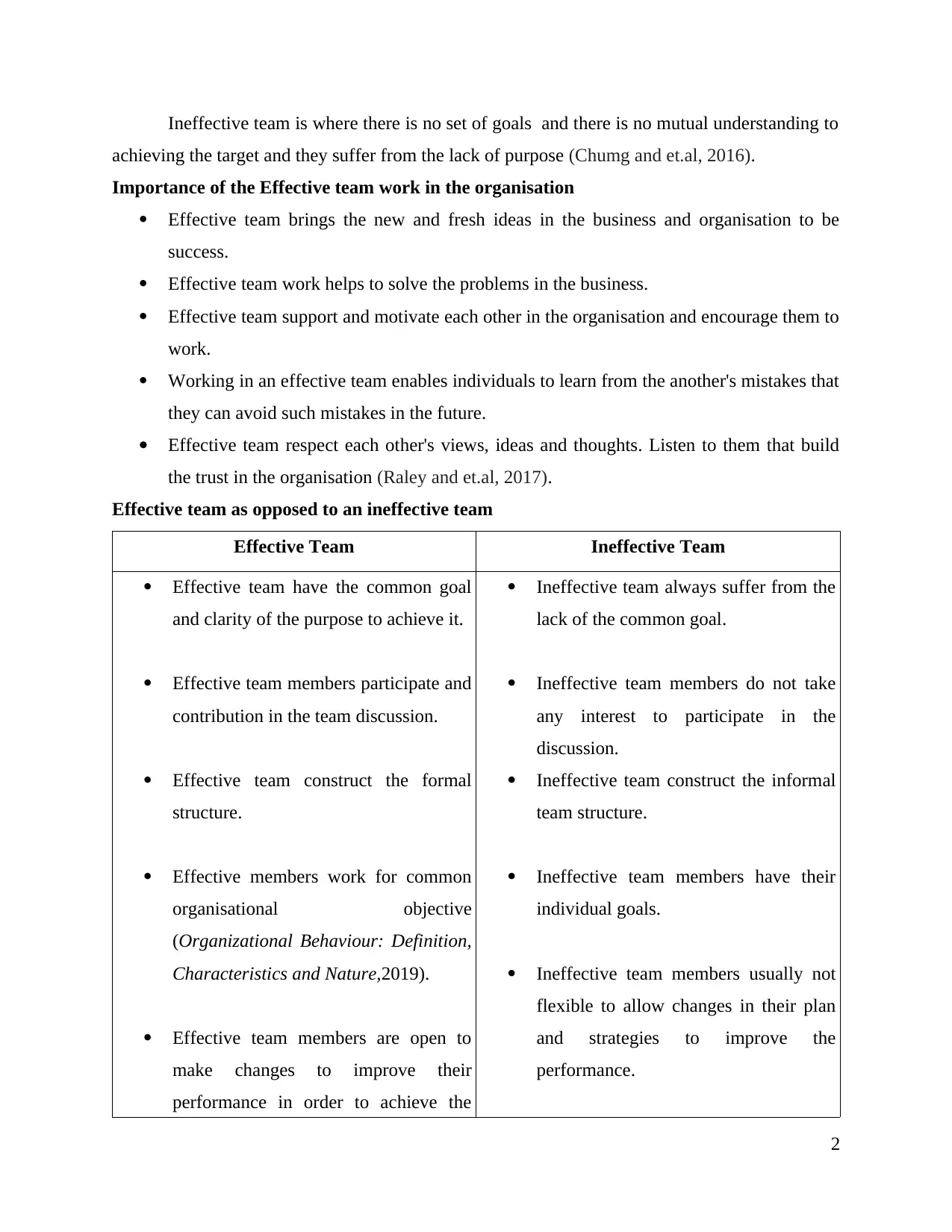
Ineffective team is where there is no set of goals and there is no mutual understanding to
achieving the target and they suffer from the lack of purpose (Chumg and et.al, 2016).
Importance of the Effective team work in the organisation
Effective team brings the new and fresh ideas in the business and organisation to be
success.
Effective team work helps to solve the problems in the business.
Effective team support and motivate each other in the organisation and encourage them to
work.
Working in an effective team enables individuals to learn from the another's mistakes that
they can avoid such mistakes in the future.
Effective team respect each other's views, ideas and thoughts. Listen to them that build
the trust in the organisation (Raley and et.al, 2017).
Effective team as opposed to an ineffective team
Effective Team Ineffective Team
Effective team have the common goal
and clarity of the purpose to achieve it.
Effective team members participate and
contribution in the team discussion.
Effective team construct the formal
structure.
Effective members work for common
organisational objective
(Organizational Behaviour: Definition,
Characteristics and Nature,2019).
Effective team members are open to
make changes to improve their
performance in order to achieve the
Ineffective team always suffer from the
lack of the common goal.
Ineffective team members do not take
any interest to participate in the
discussion.
Ineffective team construct the informal
team structure.
Ineffective team members have their
individual goals.
Ineffective team members usually not
flexible to allow changes in their plan
and strategies to improve the
performance.
2
achieving the target and they suffer from the lack of purpose (Chumg and et.al, 2016).
Importance of the Effective team work in the organisation
Effective team brings the new and fresh ideas in the business and organisation to be
success.
Effective team work helps to solve the problems in the business.
Effective team support and motivate each other in the organisation and encourage them to
work.
Working in an effective team enables individuals to learn from the another's mistakes that
they can avoid such mistakes in the future.
Effective team respect each other's views, ideas and thoughts. Listen to them that build
the trust in the organisation (Raley and et.al, 2017).
Effective team as opposed to an ineffective team
Effective Team Ineffective Team
Effective team have the common goal
and clarity of the purpose to achieve it.
Effective team members participate and
contribution in the team discussion.
Effective team construct the formal
structure.
Effective members work for common
organisational objective
(Organizational Behaviour: Definition,
Characteristics and Nature,2019).
Effective team members are open to
make changes to improve their
performance in order to achieve the
Ineffective team always suffer from the
lack of the common goal.
Ineffective team members do not take
any interest to participate in the
discussion.
Ineffective team construct the informal
team structure.
Ineffective team members have their
individual goals.
Ineffective team members usually not
flexible to allow changes in their plan
and strategies to improve the
performance.
2
Paraphrase This Document
Need a fresh take? Get an instant paraphrase of this document with our AI Paraphraser
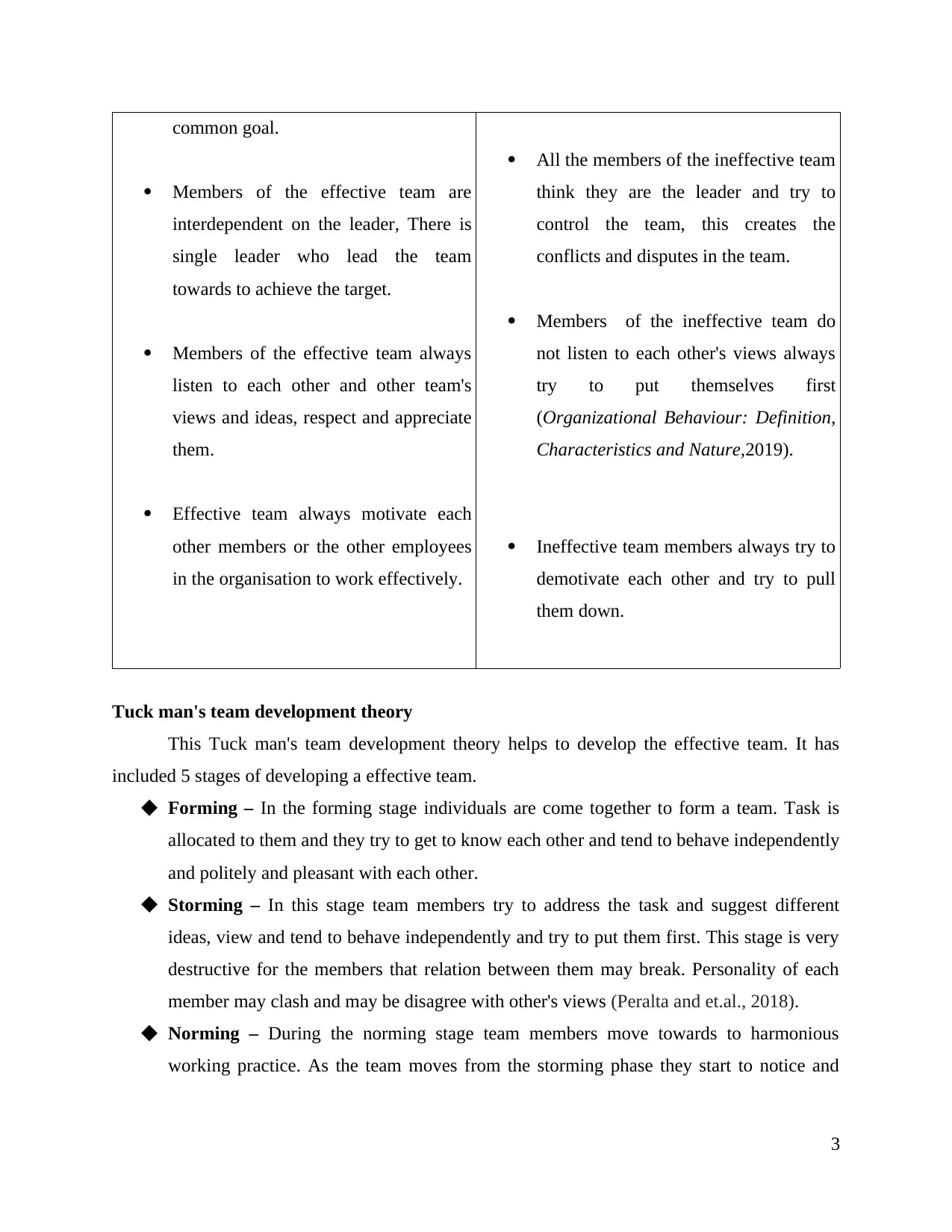
common goal.
Members of the effective team are
interdependent on the leader, There is
single leader who lead the team
towards to achieve the target.
Members of the effective team always
listen to each other and other team's
views and ideas, respect and appreciate
them.
Effective team always motivate each
other members or the other employees
in the organisation to work effectively.
All the members of the ineffective team
think they are the leader and try to
control the team, this creates the
conflicts and disputes in the team.
Members of the ineffective team do
not listen to each other's views always
try to put themselves first
(Organizational Behaviour: Definition,
Characteristics and Nature,2019).
Ineffective team members always try to
demotivate each other and try to pull
them down.
Tuck man's team development theory
This Tuck man's team development theory helps to develop the effective team. It has
included 5 stages of developing a effective team.
Forming – In the forming stage individuals are come together to form a team. Task is
allocated to them and they try to get to know each other and tend to behave independently
and politely and pleasant with each other.
Storming – In this stage team members try to address the task and suggest different
ideas, view and tend to behave independently and try to put them first. This stage is very
destructive for the members that relation between them may break. Personality of each
member may clash and may be disagree with other's views (Peralta and et.al., 2018).
Norming – During the norming stage team members move towards to harmonious
working practice. As the team moves from the storming phase they start to notice and
3
Members of the effective team are
interdependent on the leader, There is
single leader who lead the team
towards to achieve the target.
Members of the effective team always
listen to each other and other team's
views and ideas, respect and appreciate
them.
Effective team always motivate each
other members or the other employees
in the organisation to work effectively.
All the members of the ineffective team
think they are the leader and try to
control the team, this creates the
conflicts and disputes in the team.
Members of the ineffective team do
not listen to each other's views always
try to put themselves first
(Organizational Behaviour: Definition,
Characteristics and Nature,2019).
Ineffective team members always try to
demotivate each other and try to pull
them down.
Tuck man's team development theory
This Tuck man's team development theory helps to develop the effective team. It has
included 5 stages of developing a effective team.
Forming – In the forming stage individuals are come together to form a team. Task is
allocated to them and they try to get to know each other and tend to behave independently
and politely and pleasant with each other.
Storming – In this stage team members try to address the task and suggest different
ideas, view and tend to behave independently and try to put them first. This stage is very
destructive for the members that relation between them may break. Personality of each
member may clash and may be disagree with other's views (Peralta and et.al., 2018).
Norming – During the norming stage team members move towards to harmonious
working practice. As the team moves from the storming phase they start to notice and
3
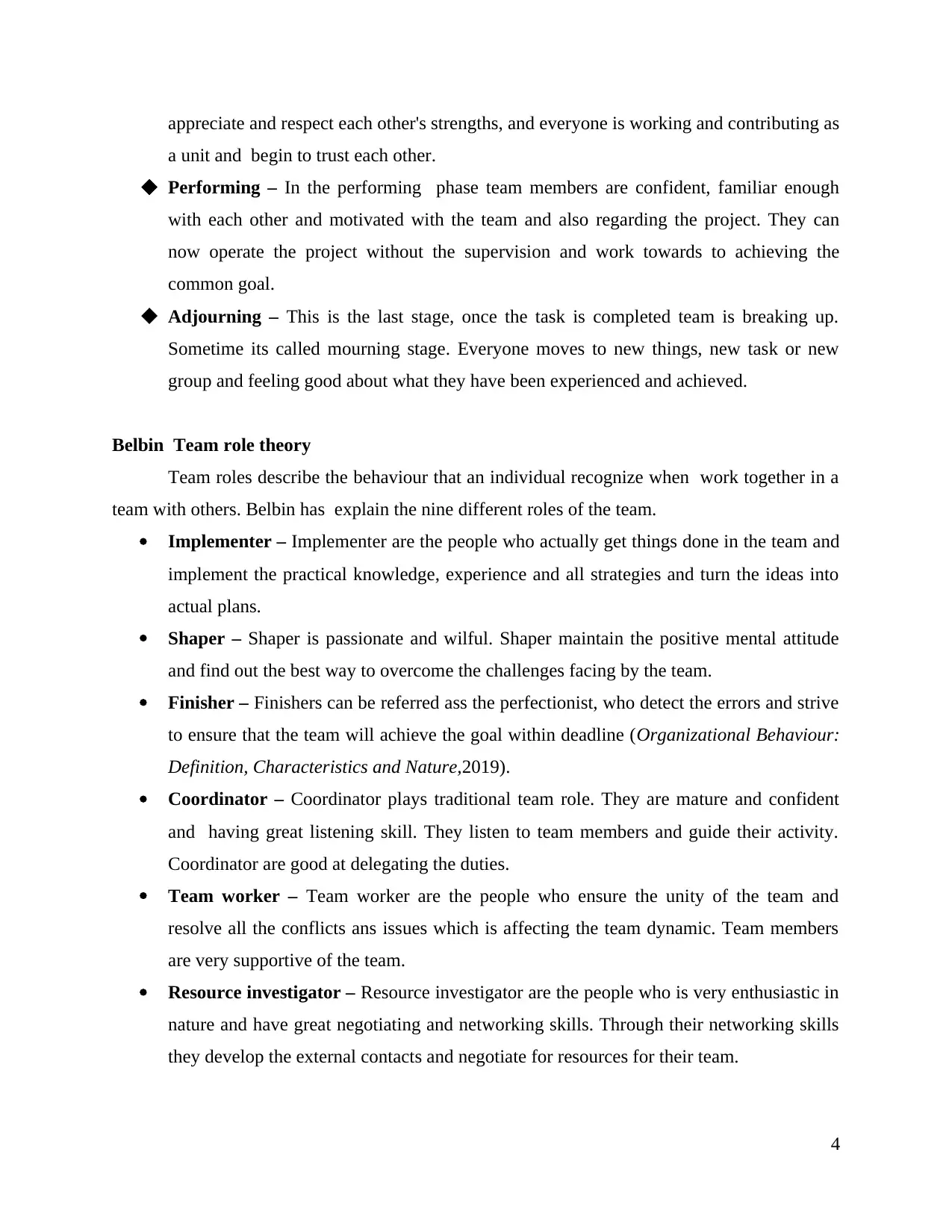
appreciate and respect each other's strengths, and everyone is working and contributing as
a unit and begin to trust each other.
Performing – In the performing phase team members are confident, familiar enough
with each other and motivated with the team and also regarding the project. They can
now operate the project without the supervision and work towards to achieving the
common goal.
Adjourning – This is the last stage, once the task is completed team is breaking up.
Sometime its called mourning stage. Everyone moves to new things, new task or new
group and feeling good about what they have been experienced and achieved.
Belbin Team role theory
Team roles describe the behaviour that an individual recognize when work together in a
team with others. Belbin has explain the nine different roles of the team.
Implementer – Implementer are the people who actually get things done in the team and
implement the practical knowledge, experience and all strategies and turn the ideas into
actual plans.
Shaper – Shaper is passionate and wilful. Shaper maintain the positive mental attitude
and find out the best way to overcome the challenges facing by the team.
Finisher – Finishers can be referred ass the perfectionist, who detect the errors and strive
to ensure that the team will achieve the goal within deadline (Organizational Behaviour:
Definition, Characteristics and Nature,2019).
Coordinator – Coordinator plays traditional team role. They are mature and confident
and having great listening skill. They listen to team members and guide their activity.
Coordinator are good at delegating the duties.
Team worker – Team worker are the people who ensure the unity of the team and
resolve all the conflicts ans issues which is affecting the team dynamic. Team members
are very supportive of the team.
Resource investigator – Resource investigator are the people who is very enthusiastic in
nature and have great negotiating and networking skills. Through their networking skills
they develop the external contacts and negotiate for resources for their team.
4
a unit and begin to trust each other.
Performing – In the performing phase team members are confident, familiar enough
with each other and motivated with the team and also regarding the project. They can
now operate the project without the supervision and work towards to achieving the
common goal.
Adjourning – This is the last stage, once the task is completed team is breaking up.
Sometime its called mourning stage. Everyone moves to new things, new task or new
group and feeling good about what they have been experienced and achieved.
Belbin Team role theory
Team roles describe the behaviour that an individual recognize when work together in a
team with others. Belbin has explain the nine different roles of the team.
Implementer – Implementer are the people who actually get things done in the team and
implement the practical knowledge, experience and all strategies and turn the ideas into
actual plans.
Shaper – Shaper is passionate and wilful. Shaper maintain the positive mental attitude
and find out the best way to overcome the challenges facing by the team.
Finisher – Finishers can be referred ass the perfectionist, who detect the errors and strive
to ensure that the team will achieve the goal within deadline (Organizational Behaviour:
Definition, Characteristics and Nature,2019).
Coordinator – Coordinator plays traditional team role. They are mature and confident
and having great listening skill. They listen to team members and guide their activity.
Coordinator are good at delegating the duties.
Team worker – Team worker are the people who ensure the unity of the team and
resolve all the conflicts ans issues which is affecting the team dynamic. Team members
are very supportive of the team.
Resource investigator – Resource investigator are the people who is very enthusiastic in
nature and have great negotiating and networking skills. Through their networking skills
they develop the external contacts and negotiate for resources for their team.
4
⊘ This is a preview!⊘
Do you want full access?
Subscribe today to unlock all pages.

Trusted by 1+ million students worldwide
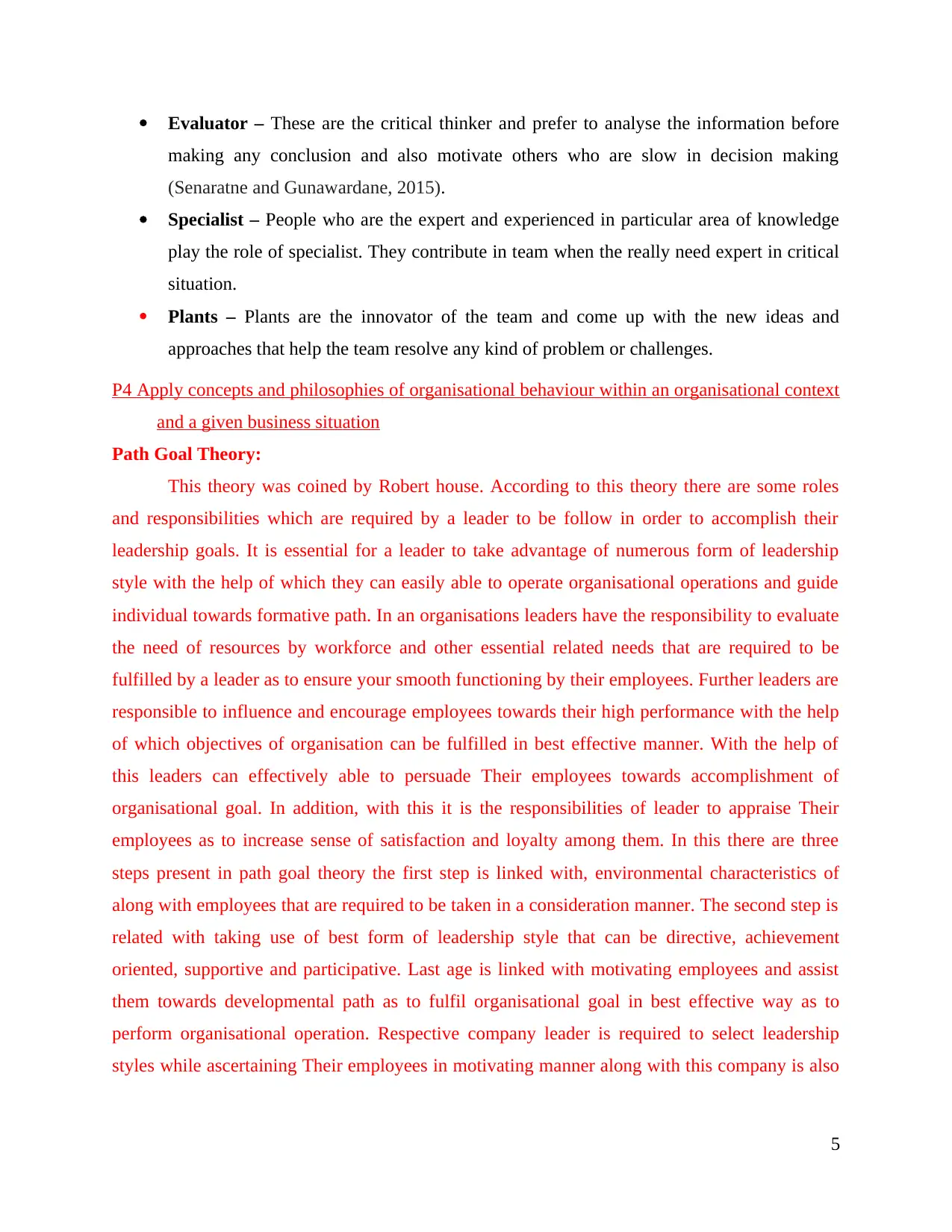
Evaluator – These are the critical thinker and prefer to analyse the information before
making any conclusion and also motivate others who are slow in decision making
(Senaratne and Gunawardane, 2015).
Specialist – People who are the expert and experienced in particular area of knowledge
play the role of specialist. They contribute in team when the really need expert in critical
situation.
Plants – Plants are the innovator of the team and come up with the new ideas and
approaches that help the team resolve any kind of problem or challenges.
P4 Apply concepts and philosophies of organisational behaviour within an organisational context
and a given business situation
Path Goal Theory:
This theory was coined by Robert house. According to this theory there are some roles
and responsibilities which are required by a leader to be follow in order to accomplish their
leadership goals. It is essential for a leader to take advantage of numerous form of leadership
style with the help of which they can easily able to operate organisational operations and guide
individual towards formative path. In an organisations leaders have the responsibility to evaluate
the need of resources by workforce and other essential related needs that are required to be
fulfilled by a leader as to ensure your smooth functioning by their employees. Further leaders are
responsible to influence and encourage employees towards their high performance with the help
of which objectives of organisation can be fulfilled in best effective manner. With the help of
this leaders can effectively able to persuade Their employees towards accomplishment of
organisational goal. In addition, with this it is the responsibilities of leader to appraise Their
employees as to increase sense of satisfaction and loyalty among them. In this there are three
steps present in path goal theory the first step is linked with, environmental characteristics of
along with employees that are required to be taken in a consideration manner. The second step is
related with taking use of best form of leadership style that can be directive, achievement
oriented, supportive and participative. Last age is linked with motivating employees and assist
them towards developmental path as to fulfil organisational goal in best effective way as to
perform organisational operation. Respective company leader is required to select leadership
styles while ascertaining Their employees in motivating manner along with this company is also
5
making any conclusion and also motivate others who are slow in decision making
(Senaratne and Gunawardane, 2015).
Specialist – People who are the expert and experienced in particular area of knowledge
play the role of specialist. They contribute in team when the really need expert in critical
situation.
Plants – Plants are the innovator of the team and come up with the new ideas and
approaches that help the team resolve any kind of problem or challenges.
P4 Apply concepts and philosophies of organisational behaviour within an organisational context
and a given business situation
Path Goal Theory:
This theory was coined by Robert house. According to this theory there are some roles
and responsibilities which are required by a leader to be follow in order to accomplish their
leadership goals. It is essential for a leader to take advantage of numerous form of leadership
style with the help of which they can easily able to operate organisational operations and guide
individual towards formative path. In an organisations leaders have the responsibility to evaluate
the need of resources by workforce and other essential related needs that are required to be
fulfilled by a leader as to ensure your smooth functioning by their employees. Further leaders are
responsible to influence and encourage employees towards their high performance with the help
of which objectives of organisation can be fulfilled in best effective manner. With the help of
this leaders can effectively able to persuade Their employees towards accomplishment of
organisational goal. In addition, with this it is the responsibilities of leader to appraise Their
employees as to increase sense of satisfaction and loyalty among them. In this there are three
steps present in path goal theory the first step is linked with, environmental characteristics of
along with employees that are required to be taken in a consideration manner. The second step is
related with taking use of best form of leadership style that can be directive, achievement
oriented, supportive and participative. Last age is linked with motivating employees and assist
them towards developmental path as to fulfil organisational goal in best effective way as to
perform organisational operation. Respective company leader is required to select leadership
styles while ascertaining Their employees in motivating manner along with this company is also
5
Paraphrase This Document
Need a fresh take? Get an instant paraphrase of this document with our AI Paraphraser
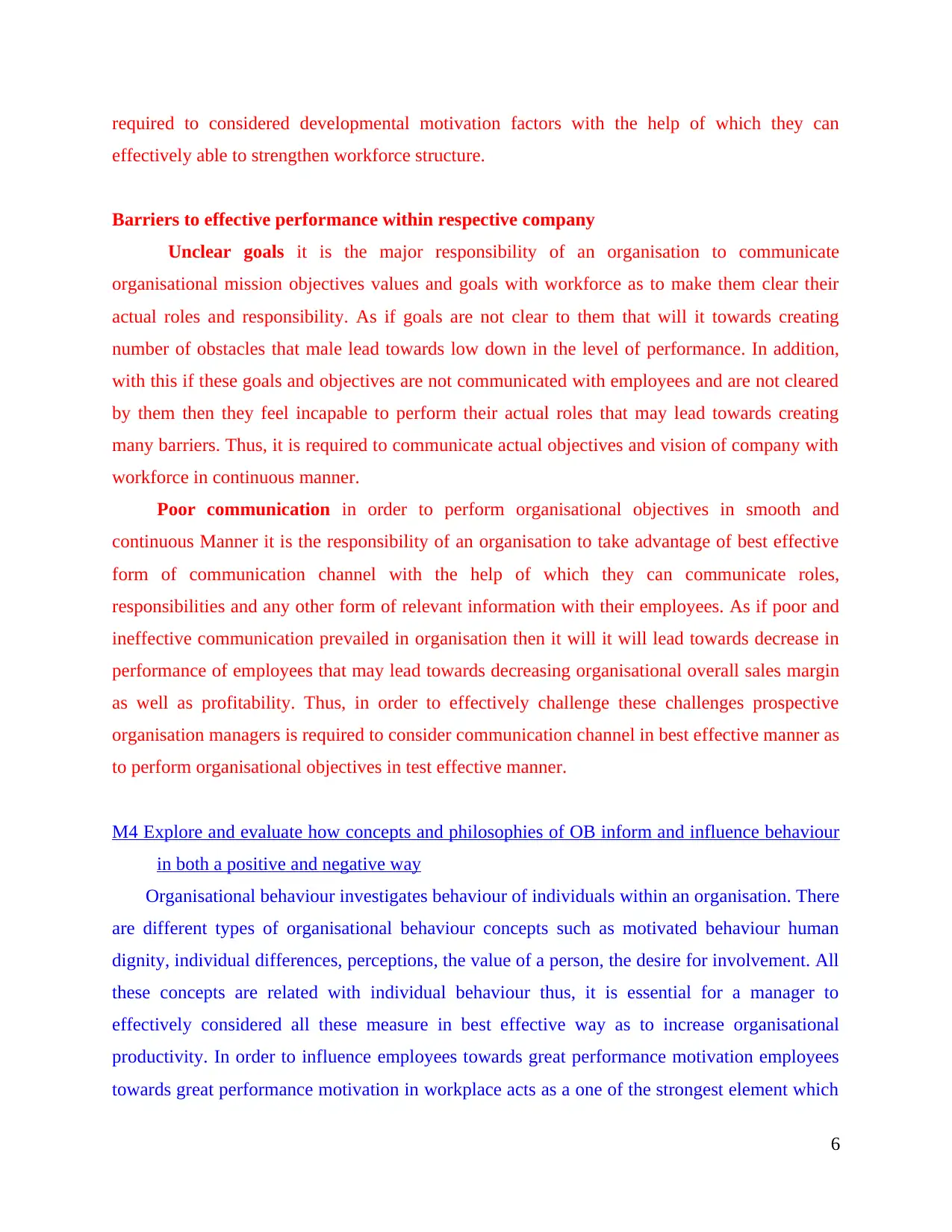
required to considered developmental motivation factors with the help of which they can
effectively able to strengthen workforce structure.
Barriers to effective performance within respective company
Unclear goals it is the major responsibility of an organisation to communicate
organisational mission objectives values and goals with workforce as to make them clear their
actual roles and responsibility. As if goals are not clear to them that will it towards creating
number of obstacles that male lead towards low down in the level of performance. In addition,
with this if these goals and objectives are not communicated with employees and are not cleared
by them then they feel incapable to perform their actual roles that may lead towards creating
many barriers. Thus, it is required to communicate actual objectives and vision of company with
workforce in continuous manner.
Poor communication in order to perform organisational objectives in smooth and
continuous Manner it is the responsibility of an organisation to take advantage of best effective
form of communication channel with the help of which they can communicate roles,
responsibilities and any other form of relevant information with their employees. As if poor and
ineffective communication prevailed in organisation then it will it will lead towards decrease in
performance of employees that may lead towards decreasing organisational overall sales margin
as well as profitability. Thus, in order to effectively challenge these challenges prospective
organisation managers is required to consider communication channel in best effective manner as
to perform organisational objectives in test effective manner.
M4 Explore and evaluate how concepts and philosophies of OB inform and influence behaviour
in both a positive and negative way
Organisational behaviour investigates behaviour of individuals within an organisation. There
are different types of organisational behaviour concepts such as motivated behaviour human
dignity, individual differences, perceptions, the value of a person, the desire for involvement. All
these concepts are related with individual behaviour thus, it is essential for a manager to
effectively considered all these measure in best effective way as to increase organisational
productivity. In order to influence employees towards great performance motivation employees
towards great performance motivation in workplace acts as a one of the strongest element which
6
effectively able to strengthen workforce structure.
Barriers to effective performance within respective company
Unclear goals it is the major responsibility of an organisation to communicate
organisational mission objectives values and goals with workforce as to make them clear their
actual roles and responsibility. As if goals are not clear to them that will it towards creating
number of obstacles that male lead towards low down in the level of performance. In addition,
with this if these goals and objectives are not communicated with employees and are not cleared
by them then they feel incapable to perform their actual roles that may lead towards creating
many barriers. Thus, it is required to communicate actual objectives and vision of company with
workforce in continuous manner.
Poor communication in order to perform organisational objectives in smooth and
continuous Manner it is the responsibility of an organisation to take advantage of best effective
form of communication channel with the help of which they can communicate roles,
responsibilities and any other form of relevant information with their employees. As if poor and
ineffective communication prevailed in organisation then it will it will lead towards decrease in
performance of employees that may lead towards decreasing organisational overall sales margin
as well as profitability. Thus, in order to effectively challenge these challenges prospective
organisation managers is required to consider communication channel in best effective manner as
to perform organisational objectives in test effective manner.
M4 Explore and evaluate how concepts and philosophies of OB inform and influence behaviour
in both a positive and negative way
Organisational behaviour investigates behaviour of individuals within an organisation. There
are different types of organisational behaviour concepts such as motivated behaviour human
dignity, individual differences, perceptions, the value of a person, the desire for involvement. All
these concepts are related with individual behaviour thus, it is essential for a manager to
effectively considered all these measure in best effective way as to increase organisational
productivity. In order to influence employees towards great performance motivation employees
towards great performance motivation in workplace acts as a one of the strongest element which
6
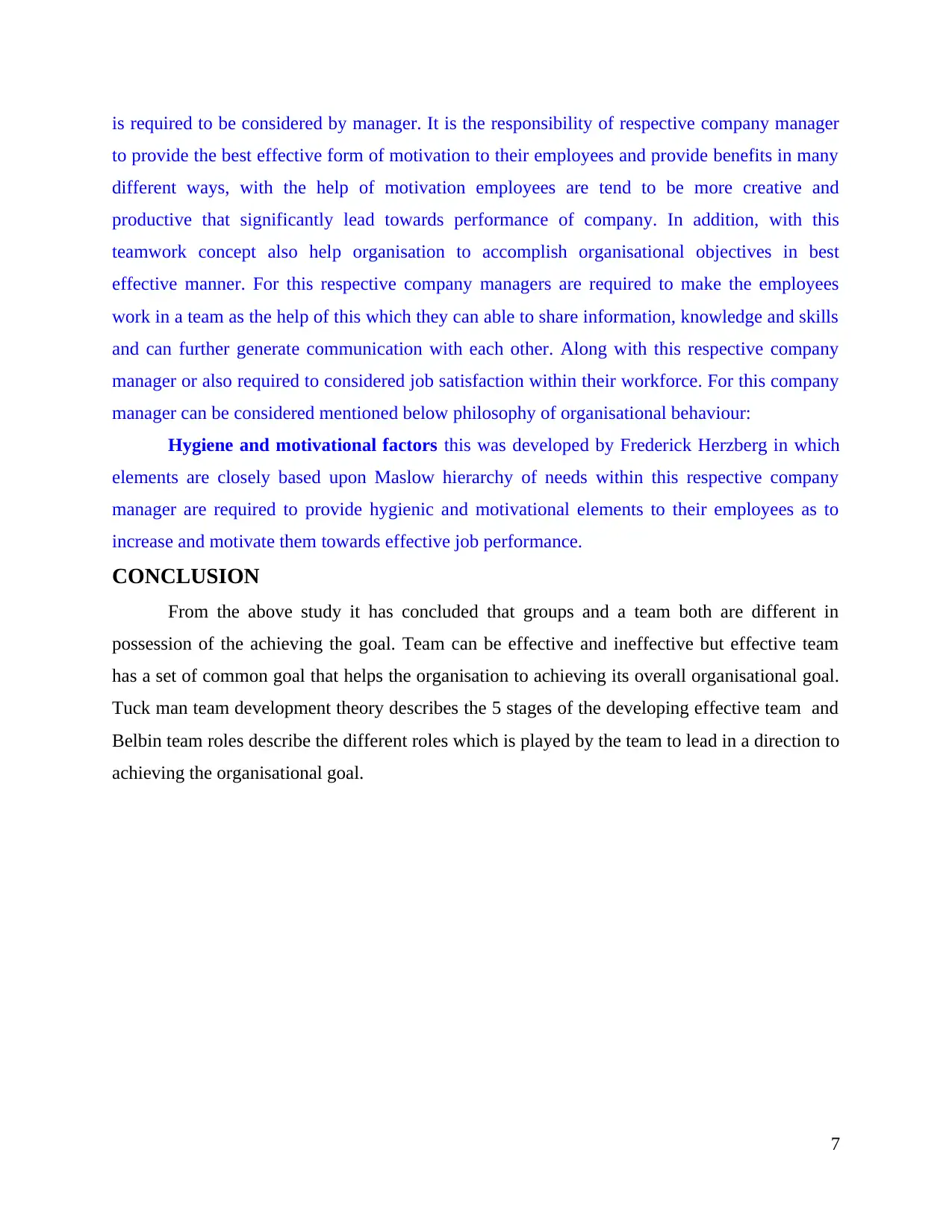
is required to be considered by manager. It is the responsibility of respective company manager
to provide the best effective form of motivation to their employees and provide benefits in many
different ways, with the help of motivation employees are tend to be more creative and
productive that significantly lead towards performance of company. In addition, with this
teamwork concept also help organisation to accomplish organisational objectives in best
effective manner. For this respective company managers are required to make the employees
work in a team as the help of this which they can able to share information, knowledge and skills
and can further generate communication with each other. Along with this respective company
manager or also required to considered job satisfaction within their workforce. For this company
manager can be considered mentioned below philosophy of organisational behaviour:
Hygiene and motivational factors this was developed by Frederick Herzberg in which
elements are closely based upon Maslow hierarchy of needs within this respective company
manager are required to provide hygienic and motivational elements to their employees as to
increase and motivate them towards effective job performance.
CONCLUSION
From the above study it has concluded that groups and a team both are different in
possession of the achieving the goal. Team can be effective and ineffective but effective team
has a set of common goal that helps the organisation to achieving its overall organisational goal.
Tuck man team development theory describes the 5 stages of the developing effective team and
Belbin team roles describe the different roles which is played by the team to lead in a direction to
achieving the organisational goal.
7
to provide the best effective form of motivation to their employees and provide benefits in many
different ways, with the help of motivation employees are tend to be more creative and
productive that significantly lead towards performance of company. In addition, with this
teamwork concept also help organisation to accomplish organisational objectives in best
effective manner. For this respective company managers are required to make the employees
work in a team as the help of this which they can able to share information, knowledge and skills
and can further generate communication with each other. Along with this respective company
manager or also required to considered job satisfaction within their workforce. For this company
manager can be considered mentioned below philosophy of organisational behaviour:
Hygiene and motivational factors this was developed by Frederick Herzberg in which
elements are closely based upon Maslow hierarchy of needs within this respective company
manager are required to provide hygienic and motivational elements to their employees as to
increase and motivate them towards effective job performance.
CONCLUSION
From the above study it has concluded that groups and a team both are different in
possession of the achieving the goal. Team can be effective and ineffective but effective team
has a set of common goal that helps the organisation to achieving its overall organisational goal.
Tuck man team development theory describes the 5 stages of the developing effective team and
Belbin team roles describe the different roles which is played by the team to lead in a direction to
achieving the organisational goal.
7
⊘ This is a preview!⊘
Do you want full access?
Subscribe today to unlock all pages.

Trusted by 1+ million students worldwide
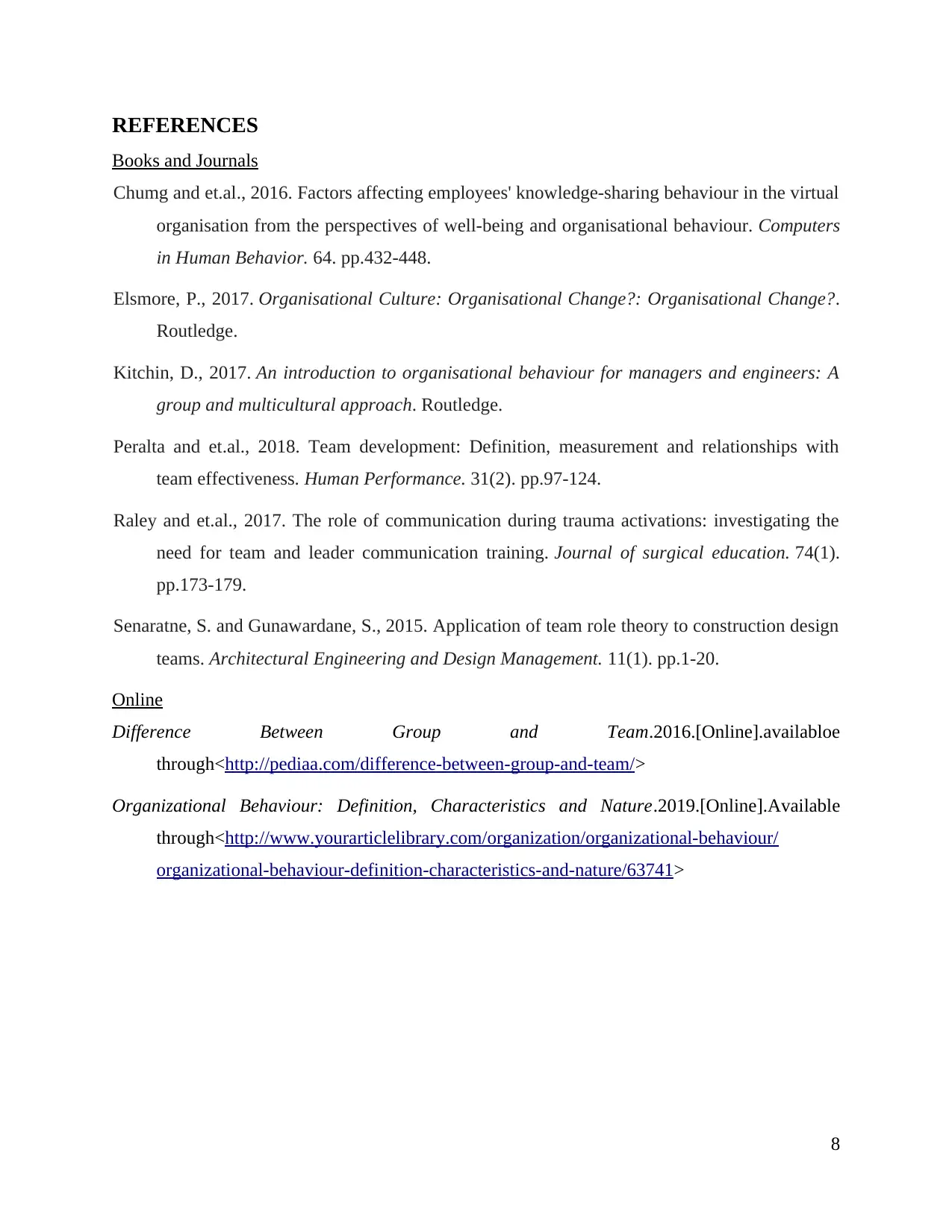
REFERENCES
Books and Journals
Chumg and et.al., 2016. Factors affecting employees' knowledge-sharing behaviour in the virtual
organisation from the perspectives of well-being and organisational behaviour. Computers
in Human Behavior. 64. pp.432-448.
Elsmore, P., 2017. Organisational Culture: Organisational Change?: Organisational Change?.
Routledge.
Kitchin, D., 2017. An introduction to organisational behaviour for managers and engineers: A
group and multicultural approach. Routledge.
Peralta and et.al., 2018. Team development: Definition, measurement and relationships with
team effectiveness. Human Performance. 31(2). pp.97-124.
Raley and et.al., 2017. The role of communication during trauma activations: investigating the
need for team and leader communication training. Journal of surgical education. 74(1).
pp.173-179.
Senaratne, S. and Gunawardane, S., 2015. Application of team role theory to construction design
teams. Architectural Engineering and Design Management. 11(1). pp.1-20.
Online
Difference Between Group and Team.2016.[Online].availabloe
through<http://pediaa.com/difference-between-group-and-team/>
Organizational Behaviour: Definition, Characteristics and Nature.2019.[Online].Available
through<http://www.yourarticlelibrary.com/organization/organizational-behaviour/
organizational-behaviour-definition-characteristics-and-nature/63741>
8
Books and Journals
Chumg and et.al., 2016. Factors affecting employees' knowledge-sharing behaviour in the virtual
organisation from the perspectives of well-being and organisational behaviour. Computers
in Human Behavior. 64. pp.432-448.
Elsmore, P., 2017. Organisational Culture: Organisational Change?: Organisational Change?.
Routledge.
Kitchin, D., 2017. An introduction to organisational behaviour for managers and engineers: A
group and multicultural approach. Routledge.
Peralta and et.al., 2018. Team development: Definition, measurement and relationships with
team effectiveness. Human Performance. 31(2). pp.97-124.
Raley and et.al., 2017. The role of communication during trauma activations: investigating the
need for team and leader communication training. Journal of surgical education. 74(1).
pp.173-179.
Senaratne, S. and Gunawardane, S., 2015. Application of team role theory to construction design
teams. Architectural Engineering and Design Management. 11(1). pp.1-20.
Online
Difference Between Group and Team.2016.[Online].availabloe
through<http://pediaa.com/difference-between-group-and-team/>
Organizational Behaviour: Definition, Characteristics and Nature.2019.[Online].Available
through<http://www.yourarticlelibrary.com/organization/organizational-behaviour/
organizational-behaviour-definition-characteristics-and-nature/63741>
8
1 out of 10
Related Documents
Your All-in-One AI-Powered Toolkit for Academic Success.
+13062052269
info@desklib.com
Available 24*7 on WhatsApp / Email
![[object Object]](/_next/static/media/star-bottom.7253800d.svg)
Unlock your academic potential
Copyright © 2020–2025 A2Z Services. All Rights Reserved. Developed and managed by ZUCOL.





